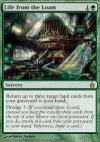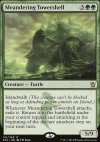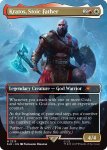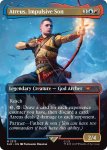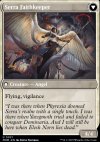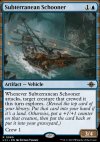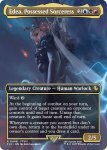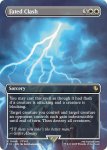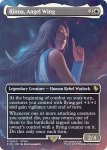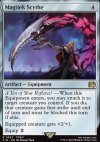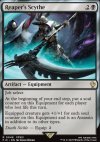|

MV anecdotes
| 4828 anecdotes trouvées |   |
Le texte d'ambiance de la carte Inevitable Defeat est une référence à celui de la carte Utter End.
Le nom de la carte Afterlife from the Loam est une référence à celui de la carte Life from the Loam.
La carte Ambling Stormshell est une référence à Meandering Towershell de par son nom, son coût de mana, son type de créature et ses force et endurance.
Les illustrations de Nathaniel Himawan pour les cartes Kratos, Stoic Father et Atreus, Impulsive Son, de l'édition Secret Lair - The PlayStation Superdrop, forment un panorama.
Source : ninesicks (instagram.com/ninesicks/), le 2 octobre 2025 a écrit :
Kratos, Stoic Father
for Magic The Gathering Secret Lair x Playstation: God of War Ragnarok
AD: Mari Hall @wizofatx
Still remembers well how Mari approached me and ask whether I would like to do MTG x God of War and geeked out right away because that journey from the game lingers with you. The scenes, battles, emotional moments, everything. And I jumped out of excitement after reading the brief that I get to do THE son and father.
This marks my first pano scene for MTG as well. All in all, everything is a blast and I hope I did these two justice!
#godofwar #gow #playstation #mtg #magicthegathering
for Magic The Gathering Secret Lair x Playstation: God of War Ragnarok
AD: Mari Hall @wizofatx
Still remembers well how Mari approached me and ask whether I would like to do MTG x God of War and geeked out right away because that journey from the game lingers with you. The scenes, battles, emotional moments, everything. And I jumped out of excitement after reading the brief that I get to do THE son and father.
This marks my first pano scene for MTG as well. All in all, everything is a blast and I hope I did these two justice!
#godofwar #gow #playstation #mtg #magicthegathering
La carte Nimblewright Schematic est une réimpression fonctionnelle de Servo Schematic, à part pour le type de créature du jeton créé.
La carte Serra Faithkeeper, obtenue par transformation de Invasion of Dominaria, ainsi que le jeton Eldrazi Angel que crée Angelic Aberration, sont des références à Serra Angel.
Pour naviguer dans les grottes étroites, le mât de la Subterranean Schooner se plie comme ceux des bateaux en bouteilles.
Les illustrations d'Eytan Zana pour les cartes Swiftwater Cliffs (édition Khans of Tarkir) et Swiftwater Cliffs (édition Fate Reforged) représentent les chutes d'Epupa, situées à la frontière entre la Namibie et l'Angola.
Source
Source
La carte Supportive Parents, de l'édition Through the Omenpaths, possède une illustration différente sur MTGO (toujours par la même artiste Elizabeth Peiró).
Source : Magic Data Science (@mtgds.bsky.social), le 5 octobre 2025 à 01:11 a écrit :
Wait -- apparently there are two different illustrations for Supportive Parents in OM1? I think one for MTGO and one for Arena?
La carte Quakebringer est inspirée du personnage de Surt dans la mythologie nordique (voir aussi cette anecdote).
Géant du feu dévastateur armé de son épée incandescente, il est celui qui tuera le dieu Freyr et détruira les mondes dans un gigantesque brasier, pendant le Ragnarök (voir aussi cette anecdote).
Géant du feu dévastateur armé de son épée incandescente, il est celui qui tuera le dieu Freyr et détruira les mondes dans un gigantesque brasier, pendant le Ragnarök (voir aussi cette anecdote).
Les cartes Peter Parker et Aunt May, illustrées par Randy Gallegos, représentent la même scène de deux points de vue différents, en face à face.
Source : Randy Gallegos, le Sep 17, 2025 a écrit :
[...]
Parker was described as being related to his earliest portrayals, and he was to be eating wheat cakes in Aunt May's home (with references given of her home from the era). While it wasn't stated explicitly, I immediately decided to rotate the camera from the Aunt May illustration, and make them one. This was perfect since the implication in Aunt May's composition was that you were at the table with her, that perhaps you were Peter. In that sense, this would almost have made a better flip card with May.
Side-by-side, you get a better sense of the compositional tie-in of these two images.
[...]
Parker was described as being related to his earliest portrayals, and he was to be eating wheat cakes in Aunt May's home (with references given of her home from the era). While it wasn't stated explicitly, I immediately decided to rotate the camera from the Aunt May illustration, and make them one. This was perfect since the implication in Aunt May's composition was that you were at the table with her, that perhaps you were Peter. In that sense, this would almost have made a better flip card with May.
Side-by-side, you get a better sense of the compositional tie-in of these two images.
[...]
Les six cartes Garland, Royal Kidnapper, The Destined Warrior, The Destined White Mage, Chaos Shrine's Black Crystal, The Destined Thief et The Destined Black Mage, de l'édition Final Fantasy Commander Decks - Garland at the Chaos Shrine et illustrées par David Rapoza, forment une seule image.
Les six cartes Brilliant Wings, Judgment of Alexander, Mega Flare, Amarant Coral, Vivi's Persistence et Search for Dagger, de l'édition Final Fantasy Commander Decks - The Siege of Alexandria et illustrées par Erion Makuo, forment une seule image.
Les six cartes Noctis, Heir Apparent, Fishing Gear, Chocobo Camp, Flash Photography, Campsite Cuisine et Warrior's Resolve, de l'édition Final Fantasy Commander Decks - Camp Comrades et illustrées par Winona Nelson, forment une seule image.
Les six cartes Edea, Possessed Sorceress, Fated Clash, Rinoa, Angel Wing, Seifer, Balamb Rival, Duelist's Flame et Squall, Gunblade Duelist, de l'édition Final Fantasy Commander Decks - Children of Fate et illustrées par Lius Lasahido, forment une seule image.
Sur l'illustration de Maxime Minard pour la carte Creeping Peeper, de l'édition Duskmourn: House of Horrors, on peut voir sur l'un des livres de la bibliothèque la Marque de l'Outsider, une référence au jeu vidéo Dishonored.
On peut également apercevoir le symbole phyrexian et l'écriture en langage Phyrexian (voir aussi cette anecdote) du nom Elesh Norn sur la tranche d'un autre livre.
On peut également apercevoir le symbole phyrexian et l'écriture en langage Phyrexian (voir aussi cette anecdote) du nom Elesh Norn sur la tranche d'un autre livre.
Sur une illustration alternative de Wayne Wu pour la carte Riverwheel Sweep, de l'édition Tarkir: Dragonstorm, le personnage ne porte pas de bandeau sur ses yeux.
Les illustrations de Kelogsloops pour les quatre Island #1, #2, #3 et #4, de l'édition Secret Lair - Dandân deck (temp), forment un panorama.
La carte Charix, the Raging Isle fait référence au monstre marin Saratan dans la mythologie arabe, un crabe géant ressemblant à une île, qui est notamment mentionné dans le premier voyage des "Sept Voyages de Sindbad le Marin", des contes des "Mille et Une Nuits".
Son nom "Saratan" veut simplement dire "crabe" en arabe ; tout comme le nom de la carte Charix vient du grec "Karis", qui désigne un crustacé.
Dans la culture populaire moderne, le Zaratan (avec un Z) devient une tortue géante. Cette version est tout particulièrement connue à travers le bestiaire du jeu de rôle Dungeons & Dragons.
Source (Zaratan dans D&D)
Son nom "Saratan" veut simplement dire "crabe" en arabe ; tout comme le nom de la carte Charix vient du grec "Karis", qui désigne un crustacé.
Dans la culture populaire moderne, le Zaratan (avec un Z) devient une tortue géante. Cette version est tout particulièrement connue à travers le bestiaire du jeu de rôle Dungeons & Dragons.
Source (Zaratan dans D&D)
Le nom de la carte Pili-Pala provient du mot gallois "pilipala" signifiant "papillon".
Pour les versions internationales de la carte, le nom Pili-Pala a été conservé dans toutes les langues utilisant l'alphabet latin, mais également en japonais, en russe et en chinois simplifié. Seule la version italienne utilise une traduction en "Sfarfallante", ce qui correspond cependant à la même étymologie car ce nom contient le mot italien "farfalla", à savoir "papillon".
Pour les versions internationales de la carte, le nom Pili-Pala a été conservé dans toutes les langues utilisant l'alphabet latin, mais également en japonais, en russe et en chinois simplifié. Seule la version italienne utilise une traduction en "Sfarfallante", ce qui correspond cependant à la même étymologie car ce nom contient le mot italien "farfalla", à savoir "papillon".
La carte Nadu, Winged Wisdom a été bannie de plusieurs formats (Modern, Commander, Duel Commander) peu de temps après sa parution.
La carte a écrasé le format Modern dès sa sortie en prenant cinq places en Top 8 du Pro Tour Modern Horizons III (aussi surnommé "Pro Tour Nadu" pour cette raison).
Wizards s'est exprimé sur la carte en parlant de "design mistake".
Source 1 - Source 2
La carte a écrasé le format Modern dès sa sortie en prenant cinq places en Top 8 du Pro Tour Modern Horizons III (aussi surnommé "Pro Tour Nadu" pour cette raison).
Wizards s'est exprimé sur la carte en parlant de "design mistake".
Source 1 - Source 2
La carte Tamiyo's Journal présente une erreur d'impression dans ses versions françaises des éditions Jumpstart 2022 (Tamiyo's Journal) et Innistrad Remastered (Tamiyo's Journal) : son texte d'ambiance n'a pas été repris à l'identique de l'original (Entrée 712 : ...) de l'édition Shadows over Innistrad, mais simplement traduit de l'anglais (Entrée 434 : ...), ce qui ne correspond plus à l'énigme associée (voir cette anecdote).
Les cartes Sea Monster (pour sa réédition dans la 10th Edition), Serpent of the Endless Sea, Shoal Serpent, Spire Serpent et Floodtide Serpent présentent une erreur de traduction dans leur version française : leur type de créature est écrit "serpent" ("Snake" en anglais) au lieu de "grand serpent" ("Serpent" en anglais, mot d'origine française utilisé pour décrire une créature marine fantastique, aux proportions colossales : un serpent de mer) ; la même erreur de traduction se retrouve dans leur nom en version française pour les quatre dernières d'entre elles (qui ont "Serpent" dans leur nom en anglais).
La carte Magitek Scythe présente une erreur de nom dans la version française de son texte Gatherer : il est écrit "Faucille magitech" au lieu de "Faux magitek" comme imprimé sur la carte, alors que c'est généralement "Sickle" qui correspond à "faucille", comme par exemple sur la carte Reaper's Scythe qui présente ces deux termes.
Search ~ Nom : Scythe - Search ~ Nom : Sickle
Search ~ Nom : Scythe - Search ~ Nom : Sickle
| 4828 anecdotes trouvées |   |






 Spider-Man / Omenpaths
Spider-Man / Omenpaths Edge of Eternities
Edge of Eternities Final Fantasy
Final Fantasy Tarkir: Dragonstorm
Tarkir: Dragonstorm Aetherdrift
Aetherdrift Foundations
Foundations Duskmourn
Duskmourn


